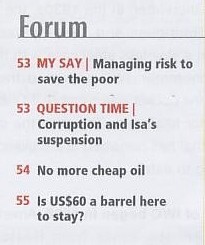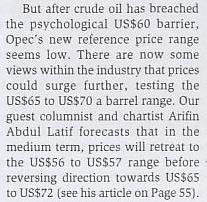|
|
|
|
Forum...My Say
Feedback from
The EDGE's Chief Editor
arifin;
a feedback from a
reader.........perhaps your take
on the market for the rest of
the year. seems to be heading
950 and above where does oil
prices fits into this. can do a
market/plus oil RT special.
salam |
|
|
|
hi che leng.
we will 4ward yr request to
ariffin. the market as measured
by KLCI has been quite upbeat.
but guess yr clients want to
know abt the second and third
liners rather than klci stocks,
right?
tks
p/s
-----
Original Message -----
From: Tan Che Leng
To:
hktat@bizedge.com
Sent: Saturday, August
13, 2005 2:54 PM
Subject: Article on
market trends
Hi Mr Ho, I am Leanne from HLG Securities Sdn Bhd. I have been an EDGE
subscriber thru my company since
many years ago. I remembered
that EDGE did have several
articles about KLSE overall
market trend by one malay guy by
the last name of Ariffin. I just
can't remember the full name.
Since the market has been in the
doldrum for so many yrs since
the technology market
burst in 2000, it might help us
to shed some lights on the
timing on when the market will
come alive again. It would be
nice to have him to write an
article on the market direction
again. I remember the last
article by him was on oil
prices. Many clients who have
been holding on second/third
liners are waiting seems to be
endless yrs for their counters
to recover. He talks
about the three inverted Buddhas
so I remembered, people are
always looking for some sheds of
light when we are still in the
dark. I can be reached at TCL@HLG.COM.MY.
Thks. |
|
|
|
|
|
|
|
|
My Say: Is US$60
a barrel here to stay?
By Arifin
Abdul Latif |
|
Surging world oil prices are the norm
nowadays, irrespective of whether one wants to
believe that speculative mania is at play.
Today, our economic masters are pointing their
fingers at speculators. Last year, Saudi
Arabia's Oil Minister Ali Naimi was quoted as
saying he did not believe oil prices would ever
reach US$60 a barrel. He said the burgeoning
influence on world oil prices from a new breed
of investors had weakened the muscle of the
Organisation of Petroleum Exporting Countries
(Opec).
"US$60 oil is here. Oil prices hit
that milestone for the first time [during
intra-trade trading] Thursday (June 23, 2005),
as the bullish frenzy that has gripped the
market for months deepened," FWN Financial News
reported.
Alas, my forecast published in the
article "Flirting with US$60 barrier?" (Issue
513, Aug 30, 2004) has materialised. No doubt,
prices will retreat, as profit-taking activities
seep into the pits of the New York Mercantile
Exchange (Nymex). That's part and parcel of
being in the marketplace — for whatever
commodity. But now, the pundits are toying with
new targets of US$70, and even US$100 per
barrel. Lest we forget, Goldman Sachs warned of
a superspike of US$105 crude! It may not happen
so soon (see my article "Oil for thought", Issue
544, April 11, 2005). It took about 10 months
for crude oil price to breach my earlier
forecast of US$60 per barrel. Will the price
remain at that level, retreat or surge ahead?
I believe for certain that speculation is
not the only culprit in the crude oil equation.
As I have argued before, among other factors,
"anything can happen under the Pax Americana
agenda". Is it pure coincidence that oil finally
breaks past the US$60 barrier for the first time
with news of Iran's President-elect, Mahmoud
Ahmedinejad, being a conservative or even a
hardliner?
Apparently, the market knows best
the potential expectations on the geopolitical
front. It happened during Gulf War I, as told
vividly by Ron Insana, CNBC's popular financial
anchor, in his book The Message of the Markets.
Is it bound to happen again — a prelude to
another heightened Iran-US confrontation that
may lead to a conflict? Classified information
does leak out as we have seen in many Hollywood
movies, and in the real world, "Deep Throat"
(though it's not oil-related) was a case in
point. Perhaps it's not an exaggeration to imply
that aside from crude/refined oil supplies and
inventories, information of such classified
nature may have its hand in the pits of Nymex,
Chicago Board of Trade and other financial
Meccas.
The global crude oil market is like
a roller coaster with a powerful force brokering
behind the scenes. Whenever a new high,
supposedly pushed by speculators (with or
without insider information), is reached, Saudi
Arabia, a major Opec producer, normally issues a
reassuring statement with or without "pressure",
primarily from its staunchest ally — the US.
Light sweet crude on June 23, 2005, touched an
intra-day high of US$60.02 per barrel on the
Nymex, but ended with a settlement price of just
below US$60. Opec's reassurance of pumping more
oil did the trick. But that was a lull before a
gathering storm, and so, it faltered again,
presumably due to fears that refiners are
struggling to keep up with demand for the second
half of the year.
The next day, crude oil
for July delivery on the Nymex hit just slightly
below US$60 per barrel. But crude oil for the
following month to July 2006 delivery ranged
from an intra-day low of US$60.10 (for August
delivery) to an intra-day high of US$62.35 (for
December delivery). These indicate fear of
pent-up demand for the third and fourth quarter
of this year. But do expect profit-taking to
resurface along the way.
What's next?
Refer to Chart 1 for my forecast
on spot crude (West Texas Intermediate [WTI] US$
per barrel) and Chart 2 for my forecast on sweet
light crude (Nymex, nearest delivery month).
In both markets, WTI is currently trending
in a major wave 3 with a slight correction bias
to wave 4. However, a 78% profit-taking index
(PTI) indicates a strong bias towards further
upside — to an extended wave 3 or wave 5.
Technically, and in Elliot wave terms, the spot
market (WTI) faces the possibility of retreating
briefly to US$56.30 to US$57.20, before
reversing its direction to US$65 to US$72.66,
and then, possibly to as high as US$79.42. That
would fit into the US$70 per barrel target which
market players are talking about now.
Likewise for the futures market (Nymex), the
numbers to take note are as follows: A possible
retreat briefly to US$56.37 to US$57.32, before
reversing to US$64.76 to US$72.67, and then,
possibly to as high as US$79.32. All in all, I
would look at US$65 as the next upside target in
the medium term.
Now, a bit on taxation as
reported by Rigzone — the upstream exploration
and production portal. Persistently high crude
prices for the past 12 months saw oil companies
in Alaska reaping more than US$5 billion,
according to a new state estimate. "The state
government is expected to pull in US$3.04
billion in oil taxes and royalties for the
fiscal year that ends Thursday. That's more oil
money than the state has collected in a year
since 1991," Department of Revenue analysts
said. However, the downside is that Alaska has a
"regressive" tax system, where the state's
percentage goes down when oil prices are high.
What about our own oil company, Petronas? Is
our government getting its fair share of the
black gold money via petroleum/petroleum
products taxation? If so, the economy should be
in better shape.
Arifin Abdul Latif is an
economic chartist based in Kuala Lumpur |
|
|
|
|
| |





